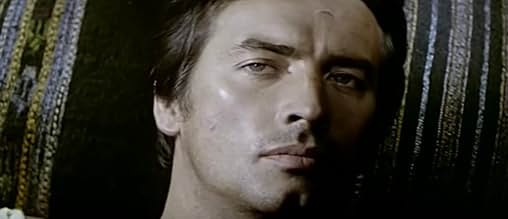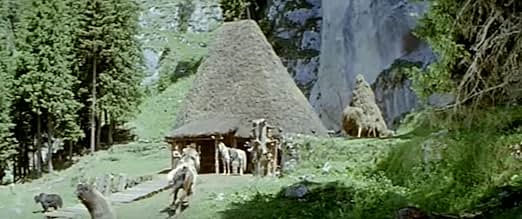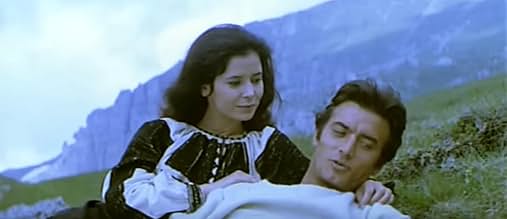AVALIAÇÃO DA IMDb
7,6/10
2,1 mil
SUA AVALIAÇÃO
Adicionar um enredo no seu idiomaThe Dacian kingdom lies at the eastern border of the Roman Empire.Only the river Danube separates the two mortal enemies.The Dacian king Decebalus knows that soon the vastly superior Roman l... Ler tudoThe Dacian kingdom lies at the eastern border of the Roman Empire.Only the river Danube separates the two mortal enemies.The Dacian king Decebalus knows that soon the vastly superior Roman legions will cross the river and attack Dacia.The Dacian kingdom lies at the eastern border of the Roman Empire.Only the river Danube separates the two mortal enemies.The Dacian king Decebalus knows that soon the vastly superior Roman legions will cross the river and attack Dacia.
- Direção
- Roteiristas
- Artistas
Ion Besoiu
- Roman Gen. Severus
- (narração)
- Direção
- Roteiristas
- Elenco e equipe completos
- Produção, bilheteria e muito mais no IMDbPro
Avaliações em destaque
"The Dacians" (Dacii) follows a very decent plot for a sword-and-sandal genre. Roman legions invade Dacia ready to become "The Masters of the World." But this Roman world is not united, but filled with intrigues and back stabbing among the Emperor and the general. "Sufro," (I suffer it) proclaims the Emperor while hiding his satisfaction. On the Dacian side, patriotism (300 Spartans style) fills their souls. "Why the Dacian smile when they die?" asks the Roman commander.
The photography of the Romanian country side and the Roman Legions on the march is excellent. The soundtrack is superb when the Roman legions are advancing. To add to the spectacle 5,000 extras fill the landscape.
Thanks to a Web site that sells Romanian movies in the NTSC format, I could watch this little jewel again. The follow up ("Column" or "The Trajan Column")seems to be unavailable.
The photography of the Romanian country side and the Roman Legions on the march is excellent. The soundtrack is superb when the Roman legions are advancing. To add to the spectacle 5,000 extras fill the landscape.
Thanks to a Web site that sells Romanian movies in the NTSC format, I could watch this little jewel again. The follow up ("Column" or "The Trajan Column")seems to be unavailable.
The newspaper "Adevarul" (the Truth) releases on DVD the "Historical" series of movies made by Sergiu Nicolaescu in the '60s, '70s and '80s. This contains the movies "Dacii" (the dacians), "Mircea", "Mihai Viteazul", "Nemuritorii" (the Imortals), "Capcana mercenarilor" (the mercenaries' trap), "Pentru patrie" (for the country). They are restored from film rolls from the National Film Archive (or national television archive), but quality is limited to VHS resolution. Given the film and audio technology level in 1967 the soundtrack is mono with subtitles in English and french. Colors are restored, but some scratches are visible throughout the movie, given its 41 years of age. Visual or audio effects were no concern for Nicolaescu, since its movies are based on historical facts transcending time and people. Fight scenes are real, using 5000 plus extras synchronized and filmed with multiple cameras, since no more than two takes were possible in one day at that scale. I don't know if the movies will be available outside the country, since are distributed only with the paper. http://www.filmeleadevarul.ro/istorice/category/filme/dacii/
surprising is a strange word for define it.but it is the reasonable one. because, it is part of a political context and it has the art to escape from it. because it gives a clear and almost touching picture of life style, laws and roots of a lost word with admirable historical accuracy. because it has the right actors and the performance of Amza Pellea is real admirable. a film about a clash, between an empire and a kingdom . and the levels of a civilization who escapes from idyllic formulas. "Dacii" remains surprising because it crashes the expectations. it is not exactly a propaganda tool and it is not a demonstration of party vision. maybe, it could be perceived as a good history lesson. in fact, a film about a land and his people.
A Romanian film – better-known, if at all, by its original title DACII – about the Roman (i.e. Italian) Empire is an absolute rarity, but I was instantly drawn to it from the evocative stills I saw on the Internet. The fact that it featured a couple of French stars in Pierre (MILL OF THE STONE WOMEN {1960}) Brice and Luis Bunuel/peplum regular Georges Marchal, then, was merely the icing on the cake; however, it did feel odd hearing them speak in a completely foreign tongue! For all its obvious naivete' (being, at best, a semi-professional enterprise and actually only the director's first feature-length effort!), the end result proves reasonably impressive – primarily on the visual front (with location photography that is indeed spectacular and the battle sequences themselves emerging as not only surprisingly elaborate but rather brutal as well!).
That said, the plot offers its own interest – with even some novelty value in store: the titular people are engaged in war against the Romans (rulers of all the known world at that time). Being Pagans, to determine whether the odds are in their favor or not, it is required that the King sacrifice his first-born i.e. a son who is literally dumped upon an upturned fork and bleeding to death! This turn-of-events naturally sours the relationship between the potentate and his daughter, who leaves the castle grounds to settle in the country. The Romans, too, have their problems: Emperor Domitien is perhaps the most condescending ever portrayed; his adviser is adamantly against invasion (believing the Dacians can be persuaded to lay down their arms without the need for carnage); their ageing if still athletic champion warrior (Marchal) is suffering from temporary blindness due to an old wound; while another 'star' officer (Brice, actually the afore-mentioned bureaucrat's son) is wounded during an initial skirmish, cured for by the Dacian king's daughter (needless to say, they end up falling in love), and ultimately revealed to be a native of the very land he is intent on conquering for the glory of Rome!
A sort of follow-up, made by other hands, was 1968's COLUMNA aka THE COLUMN which similarly featured 'recognizable' names for the international market (though their overseas exposure was extremely limited in the long run!): Briton Richard Johnson and Italians Antonella Lualdi (from Vittorio Cottafavi's THE HUNDRED HORSEMEN {1964}) and Franco Interlenghi. Actually, THE DACIANS reminded me of Robert Siodmak's two-parter STRUGGLE FOR ROME (1968) – a German epic that was only released abroad in heavily-truncated form as THE LAST ROMAN.
That said, the plot offers its own interest – with even some novelty value in store: the titular people are engaged in war against the Romans (rulers of all the known world at that time). Being Pagans, to determine whether the odds are in their favor or not, it is required that the King sacrifice his first-born i.e. a son who is literally dumped upon an upturned fork and bleeding to death! This turn-of-events naturally sours the relationship between the potentate and his daughter, who leaves the castle grounds to settle in the country. The Romans, too, have their problems: Emperor Domitien is perhaps the most condescending ever portrayed; his adviser is adamantly against invasion (believing the Dacians can be persuaded to lay down their arms without the need for carnage); their ageing if still athletic champion warrior (Marchal) is suffering from temporary blindness due to an old wound; while another 'star' officer (Brice, actually the afore-mentioned bureaucrat's son) is wounded during an initial skirmish, cured for by the Dacian king's daughter (needless to say, they end up falling in love), and ultimately revealed to be a native of the very land he is intent on conquering for the glory of Rome!
A sort of follow-up, made by other hands, was 1968's COLUMNA aka THE COLUMN which similarly featured 'recognizable' names for the international market (though their overseas exposure was extremely limited in the long run!): Briton Richard Johnson and Italians Antonella Lualdi (from Vittorio Cottafavi's THE HUNDRED HORSEMEN {1964}) and Franco Interlenghi. Actually, THE DACIANS reminded me of Robert Siodmak's two-parter STRUGGLE FOR ROME (1968) – a German epic that was only released abroad in heavily-truncated form as THE LAST ROMAN.
Best fight scenes , huge masses of soldiers , very credible movie.I saw that movie when I was a child and I was very impressed . I saw again when I grew up and still impressed. I was fascinated by the story of fighting between Dacia and Rome and when I saw this movie the stories became reality. Great performance for the unforgettable actor Amza Pellea as Decebal (the king of dacians) and the best movie of Sergiu Nicolaescu. This is a super-production in the spirit of '60 movies (Spartacus , Battle for Rome).
A movie with great Romanian and international actors. The movie is better than The Gladiator or other actual historical movies.
A movie with great Romanian and international actors. The movie is better than The Gladiator or other actual historical movies.
Você sabia?
- CuriosidadesThe Dacian costumes were hard to create. Director Sergiu Nicolaescu had to travel to Rome where he studied the Dacian costumes featured on Trajan's Column. The costumes were created by Romanian costume designer Hortensia Georgescu.
- Erros de gravaçãoIn some scenes, watches are visible on the wrists of Roman and Dacian soldiers.
- ConexõesReferenced in German Grusel - Die Edgar Wallace-Serie (2011)
Principais escolhas
Faça login para avaliar e ver a lista de recomendações personalizadas
- How long is The Dacians?Fornecido pela Alexa
Detalhes
Bilheteria
- Orçamento
- ROL 20.113.000 (estimativa)
- Tempo de duração
- 1 h 50 min(110 min)
- Mixagem de som
- Proporção
- 2.35 : 1
Contribua para esta página
Sugerir uma alteração ou adicionar conteúdo ausente





















